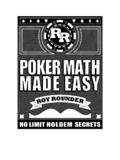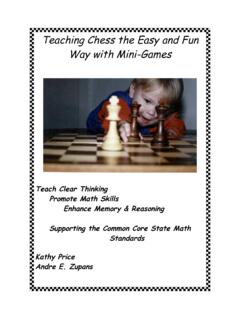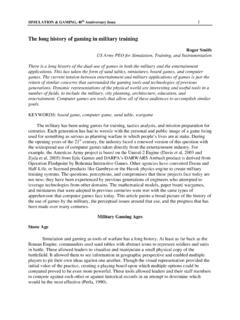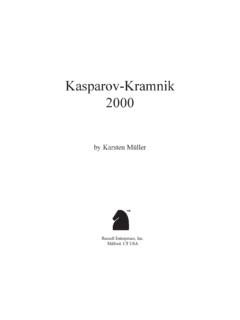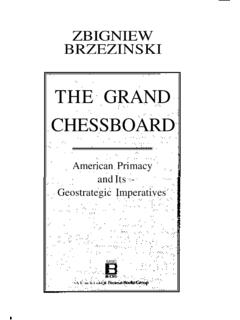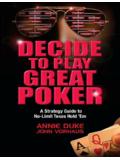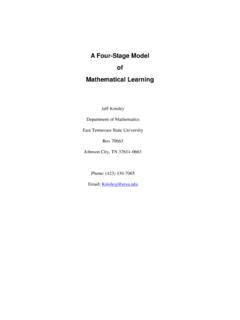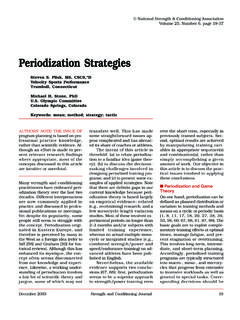Transcription of Harrington on Hold ’em Vol I - pokerbooks.lt
1 Harrington on hold em: Expert strategy for No-Limit Tournaments Volume I: Strategic Play 1 Dedication For my mother, Alice Harrington Ladyfingers: You raised tens on lousy three-flush? The Man: That s what it s all about, isn t it? Making the wrong move at the right time. From The Cincinnati Kid (1965) 2 About Dan Harrington Dan Harrington began playing poker professionally in 1982. On the circuit he is known as "Action Dan," an ironic reference to his solid, but effective style. He has won several major no-limit hold 'em tournaments, including the European Poker Championships (1995), the $2,500 No-Limit hold 'em event at the 1995 World Series of Poker, and the Four Queens No-Limit hold 'em Championship (1996). Dan began his serious games-playing with chess, where he quickly became a master and one of the strongest players in the New England area. In 1972 he won the Massachusetts Chess Championship, ahead of most of the top players in the area.
2 In 1976 he started playing backgammon, a game which he also quickly mastered. He was soon one of the top money players in the Boston area, and in 1981 he won the World Cup of Backgammon in Washington , ahead of a field that included most of the world's top players. He first played in the $10,000 No-Limit hold 'em Championship Event of the World Series of Poker in 1987. He has played in the championship a total of thirteen times and reached the final table in four of those tournaments, an amazing record. Besides winning the World Championship in 1995, he finished sixth in 1987, third in 2003, and fourth in 2004. He is widely recognized as one of the greatest and most respected no-limit hold 'em players, as well as a feared opponent in limit hold 'em side games. He lives in Santa Monica where he is a partner in Anchor Loans, a real estate business. About Bill Robertie Bill Robertie has spent his life playing and writing about chess, backgammon, and now poker.
3 He began playing chess as a boy, inspired by Bobby Fischer's feats on the international chess scene. While attending Harvard as an undergraduate, he became a chess master and helped the Harvard chess team win a number of intercollegiate titles. After graduation he won a number of chess tournaments, including the United States Championship at speed chess in 1970. He also established a reputation at blindfold chess, giving exhibitions on as many as eight boards simultaneously. In 1976 he switched from chess to backgammon, becoming one of the top players in the world. His major titles include the World Championship in Monte Carlo in 1983 and 1987, the Black & White Championship in Boston in 1979, the Las Vegas tournaments in 1980 and 2001, the Bahamas Pro-Am in 1993, and the Istanbul World Open in 1994. He has written several well-regarded backgammon books, the most noted of which are Advanced Backgammon (1991), a two-volume collection of 400 problems, and Modern Backgammon (2002), a new look at the underlying theory of the game.
4 He has also written a set of three books for the beginning player: Backgammon for Winners (1994), Backgammon for Serious Players (1995), and 501 Essential Backgammon Problems (1997). From 1991 to 1998 he edited the magazine Inside Backgammon with Kent Goulding. He owns a publishing company, the Gammon Press ( ), and lives in Arlington, Massachusetts with his wife Patrice. 3 Introduction Poker is a fascinating game with a long and colorful history. It originated early in the nineteenth century as a game called poque, centered in New Orleans and on the Mississippi riverboats. Poque used only 20 cards and permitted only one round of betting. Gradually, the game spread across the country, always evolving new forms as old variations became well-understood. Five-card draw, five and seven-card stud, lowball, hi-low, and, more recently, Texas hold em and Omaha were a few of the variations that expanded the map of poker. As time passed, the game continued to grow in popularity, from home games, to private gambling dens, to public casinos, to tournaments, to online play, and finally to televised tournaments.
5 In the last couple of years poker has exploded in popularity with the advent of minicams that enable television viewers to watch major events and follow the hands as they are played. As a result, tournaments that were once dull as dishwater can now be followed on the screen with some real understanding of what the players are trying to do. A game once mysterious has become, improbably, the latest spectator sport. Television tournaments have focused on one variation of poker in particular - no-limit Texas hold em. The no-limit variation has been used to determine poker's World Champion since the very first tournament back in 1970. Nowadays there are about as many no-limit hold em tournaments as all other kinds combined, and every major tournament has a high-stake no-limit event as its culminating contest. On television, you can watch no-limit hold em tournaments at least three days a week (not counting reruns). Online, there are thousands and thousands of no-limit hold em tournaments every day, ranging from single table events with a $1 buy-in to multi-table events with buy-ins of hundreds of dollars and prize funds of over $100,000.
6 A gap, however, exists in the world of poker. In the bookstores, there are many, many poker books, all teaching you how to play - limit hold em. There are hardly any books on the new rage these days - no-limit hold em tournaments. This is understandable if you consider the history of hold em. For many years there were just a few high-stakes no-limit hold em tournaments every year. Almost all the hold em action was in casino card rooms, where they spread limit hold em games at varying limits. If you were a newcomer to the game, small-stakes limit hold em was where you started. But now that's all changed, and many newcomers are starting with various kinds of small-stake no-limit hold em games and tournaments. So the need for a book dealing directly with this very exciting and very complex form of poker is pretty clear. Harrington on hold em: Expert strategy for No-Limit Tournaments, Volume I: Strategic Play is that book. Organization No-limit hold em is such a big and complicated game that I couldn't squeeze all the information into just one book, so Harrington on hold em is a two-volume set.
7 In this first book, Volume I, I'll show you how to play in the beginning and middle stages of a no-limit hold em tournament. Part One serves as an introduction to the game as a whole. I'll show you why no-limit hold em is considered the "Cadillac of Poker," and what you need to consider when you try to evaluate a hand. I'll also take you inside a very interesting and complex hand from the final table of the 2003 World Series of Poker. You might have seen this hand on television; I'll show you what the players were really thinking. Part Two covers playing styles. If you watched some poker on television, you've heard players described as "conservative," "aggressive," "super-aggressive," and "willing to play any two cards!" In Part Two I'll show what these terms really mean and how to play in each style. Most important, I'll explain why you need to switch from style to style as the situation demands. 4 Part Three, "Reading the Table," explains how to observe the action and keep track of both physical tells and betting patterns.
8 It also explains how to observe yourself, and why that's so important. Part Four, "Pot Odds and Hand Analysis," explains all the math you'll need to know to play no-limit hold em. (There is some, but fortunately there isn't a lot.) The chapter covers pot odds, expressed and implied odds, and analyzing hands in relation to the odds being offered. Part Five covers the whole topic of "Betting Before the Flop." I'll introduce a complete strategy for betting for value in pots that haven't been opened yet, and I'll also show you what hands you need to call or raise for value when the pot has been opened in front of you. Part Six, "Betting After the Flop," shows you how to think about your hand when the flop arrives. I'll show you a number of sample hands and compare them to various flops, explaining which flops are good, which are bad, and which are deceptively dangerous. Part Seven covers fourth and fifth street action, including getting extra money in the pot, playing against drawing hands, and betting (or not betting) on the end.
9 In Volume II I'll talk about the tough issues involved in negotiating the later stages of a tournament. There you'll find discussions of moves and bluffs, zones and inflection points, the stack ratio and what it means for your play, changing your style, playing short tables, and handling heads-up play. Master the material in these two books, and you'll know how to win a no-limit hold em tournament. The rest is up to you. The Hands Much of the real value of these books lie in the sample hands, which are collected at the end of each chapter. You should treat these hands as small quizzes, and try to answer the questions before moving on to the explanations. It would be easy to read through the text and convince yourself that, of course, you would have made exactly that play at the table, but you'll find the explanations much more informative if you wrestle with the questions on your own first. The hands have been compiled over the years from a variety of sources, including my own play, hands I've seen in major tournaments, satellites, and online events.
10 In each hand I've laid out the table position and chip counts, as well as information about some of the players at the table, if known and pertinent to the hand. Study the hands, answer the questions, read what happens next, answer the next question, and in that way work yourself through the hand. Some of the hands hinge on the single crucial decision of whether or not to enter the pot. Others involve a series of difficult moves as the hand evolves. Take the hands seriously, study them carefully, and you'll be well rewarded. Poker on television needs to appeal to a wide audience of mostly casual players. As a result, the hands selected for inclusion tend to be dramatic all-in showdowns and major clashes. I don't have any quarrel with that; if I were a television producer I'd probably do exactly the same thing. But that's not real poker. Tournaments are won and lost in the trenches, where average-plus hands butt heads with average-minus hands.
